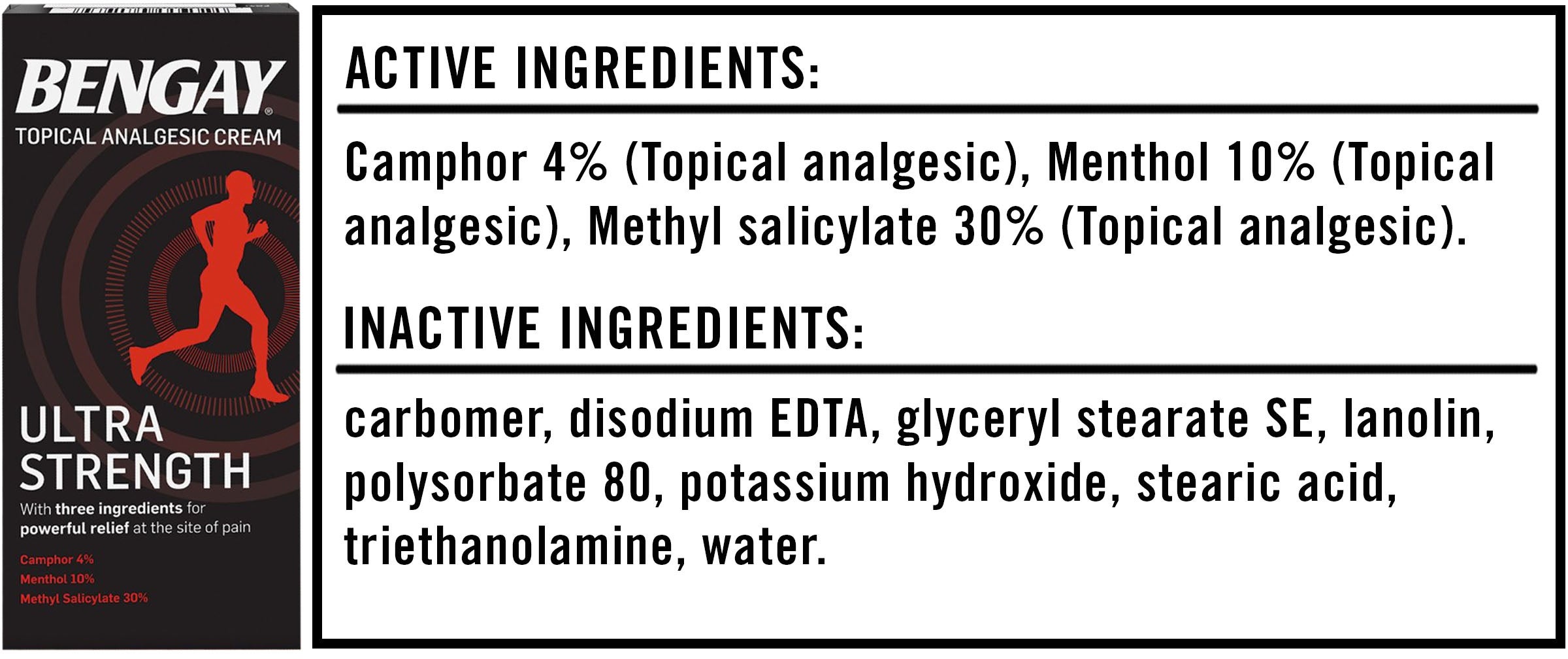We’re often told that you should never eat anything (or put anything on your body) if you don’t recognize everything on the ingredients list. But since most of us have no idea what xanthan gum or potassium benzoate are — or more importantly, what they’re doing to our bodies — we’re decoding the ingredients in the many things Americans put in (and on) themselves with the help of an expert.
This edition: Ultra Strength BenGay, which is made from 12 separate ingredients that we’ve broken down in the exact order they appear on their website.

The Ingredients
1) Camphor: This is the first of three active ingredients in BenGay, and while it used to be made by distilling the bark and wood of the camphor tree, these days, it’s chemically manufactured from turpentine oil. When applied to the skin, camphor increases local blood flow and acts as a so-called counterirritant — i.e., it causes a cool-but-warm sensation (or irritation) that basically distracts the user from underlying aches and pains. But beware: Applying camphor to broken skin can allow it to enter the body and reach concentrations that are high enough to be poisonous.
It’s also worth emphasizing that topically applying camphor (and the the following active ingredients, which are also counterirritants) can cause mild redness and irritation. After all, that’s kinda the point: They basically cause a mild skin irritation (that tingling sensation), which distracts us from our sore muscles.
2) Menthol: Sourced primarily from peppermint, menthol is another counterirritant that causes a cool-but-warm sensation. This is the second listed active ingredient in BenGay.
3) Methyl Salicylate: Yet another counterirritant (and active ingredient), methyl salicylate is also known as wintergreen oil and has anti-inflammatory properties. Once again, it’s used in BenGay to soothe underlying irritation by providing that cool-but-warm wintergreen tingle.
4) Carbomer: Carbomer is a term used for a series of polymers usually made from acrylic acid, which all sounds science-y, but the end result is basically just a fluffy, white powder used as the basis for this lotion.
5) Disodium EDTA: Disodium EDTA is a preservative that “binds to metals like iron, which slows the rate of oxidation, and thus, the development of rancid aromas,” Gavin Lavi Sacks, associate professor and academic director of Cornell University’s Food Science & Technology at Geneva Program, told us during our exploration of the many ingredients in McDonald’s Big Mac (yes, an ingredient that’s in BenGay is also in your Big Mac).
6) Glyceryl Stearate SE: This is a surfactant and an emulsifier, helping the ingredients blend together and making BenGay appear creamier. Studies have concluded that it’s totally safe for topical application.
7) Lanolin: Lanolin is a waxy substance produced by the skin glands of sheep to condition their wool. It’s usually added to cosmetics for its skin-softening qualities, but watch out for this ingredient if you have sensitive skin: It’s notorious for causing allergic reactions.
8) Polysorbate 80: This is primarily used as an emulsifier. Eating polysorbate 80 is a bad idea, though: It promotes inflammatory bowel disease and a cluster of obesity-related diseases known as metabolic syndrome, according to a 2015 animal study.
9) Potassium Hydroxide: Potassium hydroxide is commonly added to cosmetics to control the pH value, which basically keeps the product stable for long periods of time. In higher concentrations, potassium hydroxide can aggravate the skin, but the counterirritants in BenGay are probably more worrisome in that regard.
10) Stearic Acid: Stearic acid is often used as a surfactant or an emulsifier, once again helping the ingredients blend together to provide a product that spreads easily and isn’t too thin. While some animal studies suggest that stearic acid can cause skin irritation even at low doses, further reviews seem to argue that it’s generally a safe, mild ingredient.
11) Triethanolamine: While triethanolamine is primarily used in cosmetics to control the pH value, it can also act as a buffering agent, a fragrance ingredient or a surfactant — all of which basically work to make a lotion that people actually enjoy putting on their skin.
12) Water: This one’s easy:
The Takeaway
BenGay is actually way less intense of a pain reliever/medicine than I expected: It basically relies on mild counterirritants derived from plant oils to distract the user from their muscle pains, rather than doing anything that actually heals you. The non-active ingredients are fairly harmless, which is always a plus, but it’s really just a way to take your mind off aches and pains.
Still, my overall consensus? I would totally apply it to my sore bits. Depending, of course, where those sore bits are.

